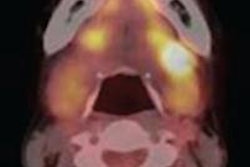Routine use of follow-up PET/CT scans can detect local cancer recurrences before they become clinically apparent, and may improve outcomes of subsequent salvage therapy, according to a study presented on Friday at the Multidisciplinary Head and Neck Cancer Symposium in Phoenix.
In a press conference, Dr. Yasir Rudha, from St. John Hospital/Van Elslander Cancer Center in Grosse Pointe Woods, MI, reported the results of a retrospective study of 234 patients treated for squamous cell carcinoma of the head and neck. Between 2006 and 2010, all patients had a post-therapy PET/CT scan six to nine weeks after undergoing chemoradiotherapy.
The researchers reviewed patient charts to identify individuals who showed no clinical evidence of recurrence at the time the PET/CT scan was performed. A total of 45 patients showed positive findings on PET/CT scans, which were correlated with pathological findings and other radiological studies. Cases were coded as having had true-positive or false-positive CT scans.
Post-therapy PET/CT identified 15 patients with abnormalities that required further evaluation. Of these, eight patients had a malignancy based on their biopsy findings. Six of the eight patients showed persistent disease at the primary site, one patient had regional lymph node recurrence, and one patient had colon cancer.
In total, the false-positive rate was 46.7%. "Before we conducted this analysis, we expected the false-positive rate to be about 90%, and we were surprised that it proved to be so low," Rudha said. "What we have learned from this is that if a patient does have a positive PET scan, we will wait 90 days before performing another one. The positive findings could be inflammation or physiological uptake."
The study also reinforced the cancer center's protocol of performing a follow-up PET/CT scan on every patient treated for head and neck squamous cell carcinoma because of the examination's high negative predictive value, and also because the false-positive rate was so low.
"If we can rule out cancer early, or identify local recurrences before they are clinically apparent, this is of great benefit to everyone," Rudha explained.
The study did not include a cost analysis, Rudha said, although this had been part of the original study design. He explained that the hospital would like to save the patient and his or her health insurance company the extra cost, not to mention the high radiation dose exposure of the procedure. However, because a PET/CT exam eliminated uncertainty about the success of the treatment for the majority of the patients, the department felt the cost and radiation dose exposure were justified, he said.
"A negative post-therapy PET scan appears to be an excellent predictor of freedom from future locoregional recurrence," he concluded.




















